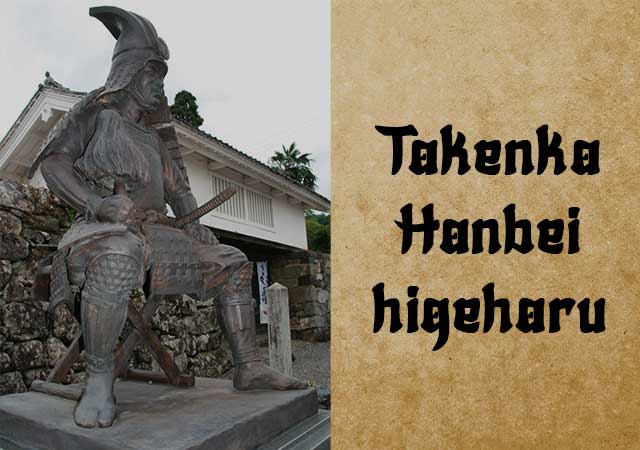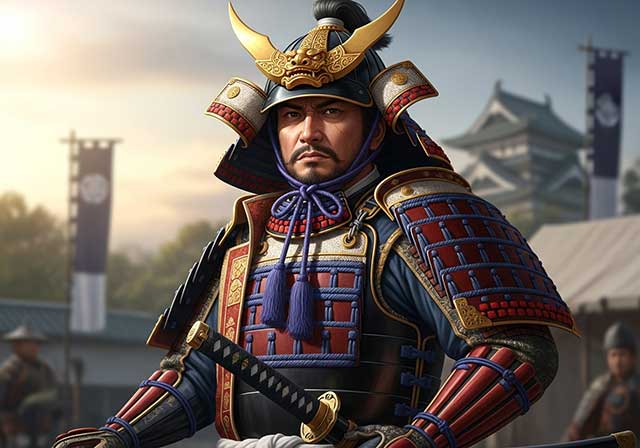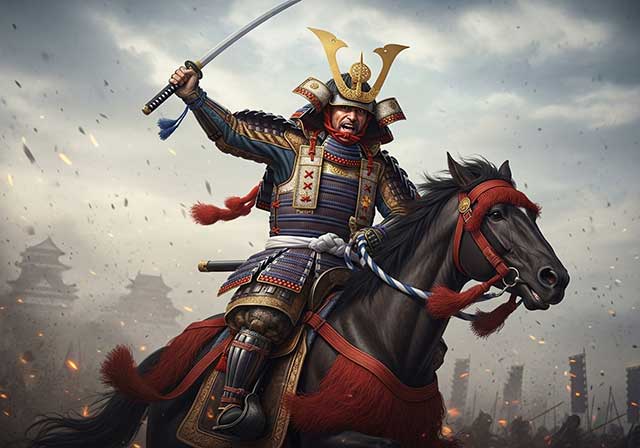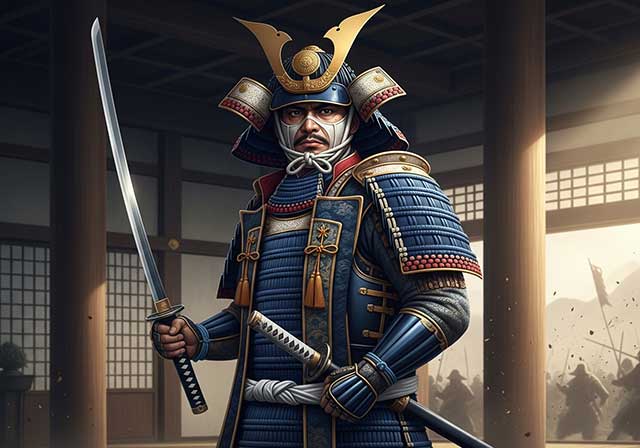
Takenaka Shigeharu, known today as Hanbei, though historical records suggest he didn't use this name in his lifetime, hailed from Mino (Gifu). Hanbei emerged as a gifted strategist during the tumultuous Sengoku period, serving as a military advisor to both Saito Yoshitatsu and his son, Saito Tatsuoki, the lords of Gifu Castle. Despite his strategic brilliance, Hanbei was reputedly frail and delicate in appearance.
In a remarkable feat, Hanbei, accompanied by just 16 followers, successfully captured the seemingly impregnable Gifu Castle. Legend has it that Hanbei's effeminate demeanor led to a grave insult from a samurai of Gifu Castle, who allegedly urinated on him as he passed beneath a defensive turret. Despite Hanbei's appeals for justice to Saito Tatsuoki, the lord of the castle, no action was taken against the offender.
In a daring move, Hanbei exploited an opportunity to infiltrate the castle under the guise of visiting his ailing brother. Once inside, he seized the chance to launch an assassination attempt on Saito Tatsuoki. Confounded by the sudden attack, the cowardly Tatsuoki mistook Hanbei's actions for a full-scale invasion and fled in panic, abandoning the castle and his forces. Thus, Hanbei secured control of Gifu Castle with ease.
Toyotomi Hideyoshi was deeply impressed by Hanbei's strategic prowess and extended an offer for him to join his army. Similarly, Oda Nobunaga sought Hanbei's assistance in securing the castle. However, Hanbei declined Nobunaga's request, opting instead to return the castle to Tatsuoki, who was left humiliated and dishonored by his earlier retreat.
When Oda Nobunaga launched an assault on the castle two years later in 1564, the troops under Tatsuoki's command, still bearing the stigma of his cowardice, either fled or switched sides to support the Oda forces.
Swearing allegiance to the Oda clan, Takenaka Hanbei participated in campaigns against the Azai clan in Omi (now Shiga Prefecture) and the capture of Inabayama Castle in Gifu. Subsequently, Hanbei and another esteemed strategist, Kuroda Kanbei, both served as advisors to Toyotomi Hideyoshi.
Retiring from active service due to illness, Hanbei assumed responsibility for the nine-year-old son of his colleague and friend, Kuroda Kanbei, while Kuroda was away on a mission to the Araki clan in 1577. However, Kuroda was captured and imprisoned by the Araki, leading Oda Nobunaga to mistakenly believe that Kuroda had betrayed him. In a fit of rage, Nobunaga ordered Hanbei to execute Kuroda's son, Nagamasa. Hanbei, refusing to carry out such a cruel command, patiently awaited his master's temper to subside and for the truth of the situation to emerge, ultimately saving the boy's life.
One year later, Takenaka Hanbei fell victim to illness at the age of 34 while involved in the siege of Miki Castle, a pivotal engagement in Hideyoshi’s military campaign against the Mori clan in the Chugoku region. Despite his fragile health, he was carried in a palanquin. Although he had temporarily left Hideyoshi's side during the campaign to recover in Kyoto, he returned to be by Hideyoshi's side when the latter passed away on July 6, 1579.
Hanbei's son and successor, Shigekado, remained dedicated to serving Hideyoshi. He later aligned with the Eastern forces under Tokugawa Ieyasu at Sekigahara and was subsequently appointed as Hatamoto.
See also
-
Hattori Hanzo

Hattori Hanzō, also known by the name Hattori Masanari, was the third son of Hattori Yasunaga, a samurai who served the Matsudaira clan. In his childhood he was called Tigachi Hanzō. His father held the highest rank in the shinobi hierarchy, that of jōnin, and Hanzō followed in his father’s footsteps, choosing the same path.
-
Hatano Hideharu

Hatano Hideharu was the eldest son of Hatano Harumichi, the head of the Hatano clan. However, in childhood he was adopted by his uncle, Hatano Motohide, and was therefore formally regarded as Motohide’s heir. From the time of Hideharu’s grandfather, Hatano Tanemichi, the Hatano clan had been a vassal of the powerful Miyoshi house, which exerted considerable influence over the Ashikaga shoguns and effectively shaped the political situation in the region. Early in his career, Hideharu served Miyoshi Nagayoshi and, judging by surviving records, held a fairly high position within his lord’s hierarchy, as he was among the select group invited to the enthronement ceremony of Emperor Ōgimachi in 1557.
-
Fukushima Masanori

Fukushima Masanori, a samurai from Owari Province, served Toyotomi Hideyoshi and took part in the Battle of Shizugatake, where he distinguished himself so conspicuously that he was awarded the honorary title of one of the “Seven Spears of Shizugatake,” meaning the warriors who had shown the greatest valor in the battle. As a reward for his courage and martial prowess, he was granted land producing an income of 5,000 koku of rice.
-
Uemura Masakatsu

Masakatsu was a member of the Uemura clan and the son of Uemura Masatada; from an early age he served Tokugawa Ieyasu. During the Ikkō-ikki uprising in Mikawa Province in 1563, having converted from the Jōdo Shinshū Buddhist sect to the Jōdoshū sect, he took part in suppressing the rebels. After these events, Masakatsu was appointed a military governor and was granted land holdings. According to a number of sources, he was one of the so-called “Three Governors of Mikawa” (Mikawa sanbugyō), together with Amano Yasukage (1537–1613) and Koriki Kiyonaga (1530–1608).
-
Tomoe Gozen

Gozen is regarded as one of the few historically documented examples of true female warriors of feudal Japan, known as onna-musha or onna-bugeisha. Although Japanese history records countless women who at various times were forced to take up arms—for example, in defense of their castles—Tomoe Gozen was, without any doubt, a genuinely skilled and accomplished fighter. She was the wife of Kiso (Minamoto) Yoshinaka, although The Tale of the Heike describes her more as a female vassal. Yoshinaka rose in rebellion against the Taira clan and, in 1184, captured Kyoto after his victory at the Battle of Kurikawa. After the Taira were driven into the western provinces, Yoshinaka began insistently asserting that he alone was worthy of assuming leadership of the Minamoto clan and taking on the mantle of its head.
-
Tachibana Muneshige

Tachibana Muneshige was born the eldest son of Takahashi Shigetane, one of the principal retainers of the Ōtomo clan and commander of Iwaya Castle. In childhood, he bore the name Senkumamaru. His early years coincided with a period of intense military confrontation between the Ōtomo clan and other powerful warrior houses of Kyūshū—namely the Shimazu, Akizuki, and Ryūzōji clans.
-
Tachibana Dosetsu

Tachibana Dōsetsu is the name by which Hetsugi Akitsura is more widely known; the name of this lineage is also found read as Hekki or Bekki. For a long period, Akitsura served the Ōtomo clan, the daimyō of Bungo Province, and took part in wars against the Ōuchi family, the principal enemies of the Ōtomo in northwestern Kyushu. In the 1560s, Akitsura seized the castle of the Tachibana clan, which had rebelled against the Ōtomo, and thereafter adopted the surname Tachibana. Around the same time, he took Buddhist vows and assumed the name Dōsetsu, which means “Snowy Road.”
-
Taira no Masakado

Taira no Masakado embodied the quintessential samurai of his era—self-assured, harsh, and unyielding. In his youth, he served in the palace guard and repeatedly proved his bravery while suppressing unrest. Thanks to these achievements, Masakado sought the post of chief of the capital’s military-police office (the kebiishi-chō), but he was rejected: by that time, nearly all court positions—now little more than privileged sinecures—were controlled by members of the powerful Fujiwara clan.

